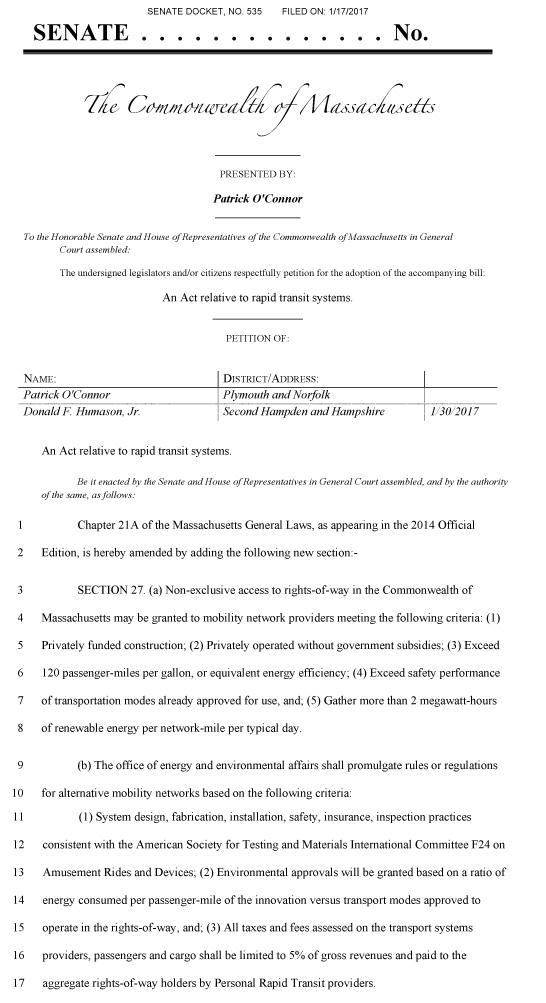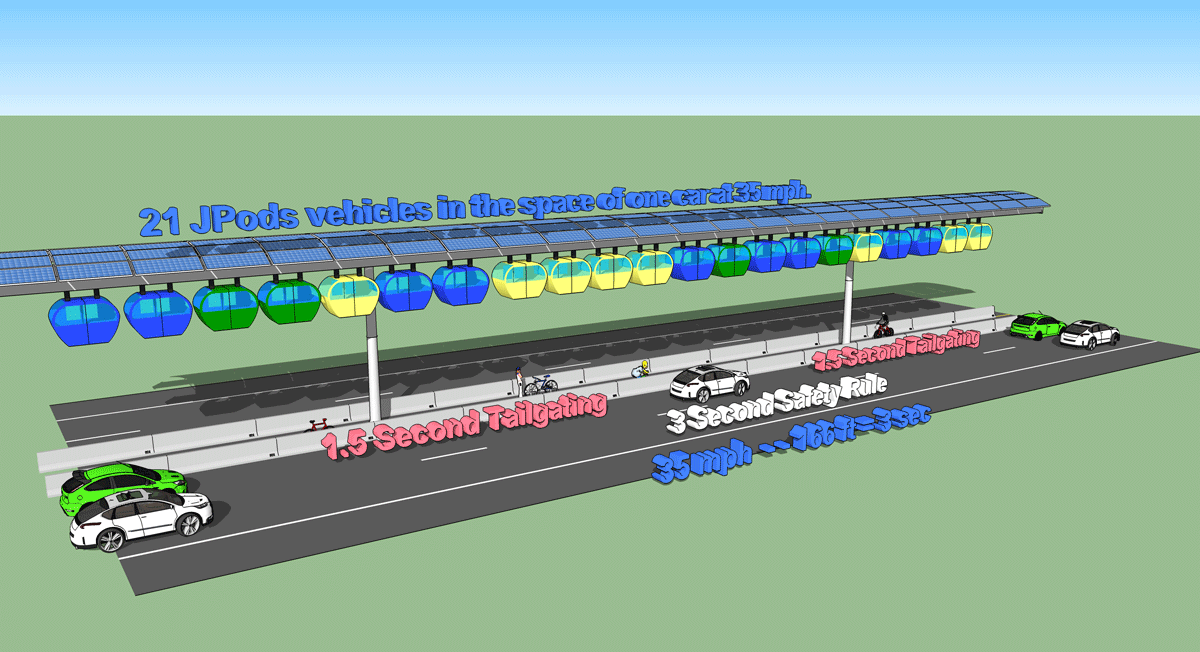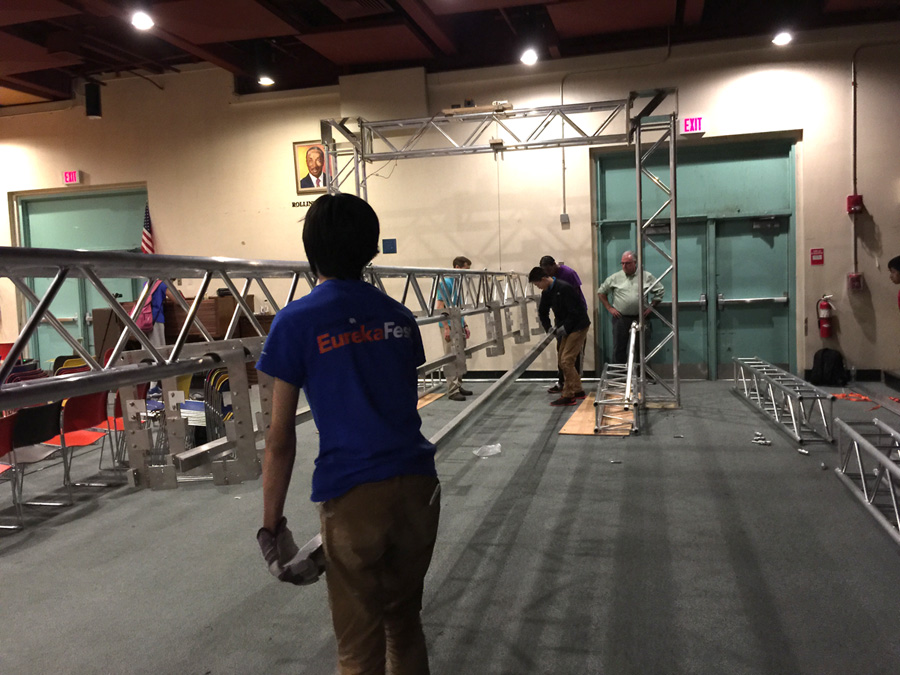San Jose, CA
Traffic costs the people of California $77 billion per year:
- $32.4 billion per year for oil.
- $33.5 billion per year of accidents
- $11.0 billion per year for congestion

Most of these costs can be rcovered as value by passing the Solar Mobility Act. The Solar Mobility Act restores liberty to innovate transportation infrastructure based on:
- Build with private capital.
- Operate without government subsidies.
- Exceed 5 times the energy efficiency of highways.
- Exceed the safety of highway.
- Gather 2 megawatt-hours of energy per mile per typical day.
- Pay 5% of gross revenues for use of air space over city streets.
- Regulate based on the ASTM F24 Theme Park Standards:
- 4.5 per million injury-rate when regulated by Theme Park Standards.
- 106 deaths per million regulated by DOT.
In 1982 liberty to innovate communications infrastructure was restore when courts forced an end to the unconstitutional Federal communications monopoly. Millions of jobs resulted as commercial innovator offered innovations and people sorted those choices in free markets.
Liberty is society’s tolerance of disruptive minorities offering choices. The Solar Mobility Act restores liberty to offer solar-powered mobility choices to unconstitutional government mandated oil/coal fired infrastructure.
Links to:
- Success of Morgantown’s Personal Rapid Transit (PRT or podcar) network. This network opened 42 years ago (1975). In that period it has delivered 110 million oil-free, injury-free passenger-miles. In that same period 1.7 million Americans died on roads. As the Federal communications stifled innovation in the century of rotary telephones,
- 10x Benefits
- 10x Capacity
- 1000x Safety
- 100% Solar Powered
- Boston City Council Hearing 2015
- Progress for building Solar-Powered Mobility Networks in Bengaluru, India:
- JPods Robotics and Network Software on SkyRide
The problem with pollution and traffic congestion is we are moving two tons to move a person. JPods remove the Parasitic Mass and repetitive applications of power required from Start-Stop traffic. To illustrate how little energy is required, we allowed people to push a JPods mobilie network setup in front of Boston City Hall as part of Boston Green Fest. The small girl is pushing her mother. Judeth (75 years old) pushes a JPods vehicle with 3 people.
90 Second Summary of JPods
The deployment of self-driving cars on city streets underscores there is no technical barrier to deploying self-driving pods on grade separated rails. The grade separate rails preempts safety defects of highways and energy wasted in start-stop traffic. The area over the top to the rails allows solar collectors to gather 40,000 vehicle-miles of power per mile of rail per day.
JPods3D software for modeling networks in SketchUp. Connecting Cottle and Blossom Hill Train Stations San Jose, CA.
JPods Route-Time® software calculation travel times, vehicles needed, and congestion risks. CA San Jose 85-101 Intersection, Old IBM Campus Area
JPods Stations are off-line. You go non-stop from origin to destination, by passing all stations in route. Jpods Station Animation
Capacity is radically greater than highways, buses, and trains. People look at a train full of people and think they can carry a lot of people. They fail to look at long the tracks are empty between trains. It is not how many people fit in a vehicle, but how many can fit through the network that determines capacity.

Students at John D. O’Briant Middle School, Dorchester, MA experiencing how to assemble the JPods mobile demo unit. Garden Girl’s 2012 Presentation to Fremont City Council. We can teach our children how to build a sustainable world. Link to download JPods3D and Route-Time software tools to design sustainable communities.

JPods has been working solve traffic congestion in San Jose for a decade.
JPods has been working to end traffic congestion and road kills in San Jose for a decade, 2008 Proposals by JPods to build solar powered mobility networks. ABC-7 San Jose News Story on JPods.
In 1974 the Congressional Office of Technology Assessment Study PB-244854 warned that DOT “institutional failures” would block expansion of PRT beyond Morgantown. DOT have proven this warning to be true.
Compare two types of mobility networks and how they are regulated:
- Theme Parks are subject to civil and criminal accountability for their actions:
- Result: 4.5 injuries per million with 294 million visitors per year.
- DOTs are self-regulated and have sovereign immunity to exempt their decisions from being held accountable:
- Result: 106 deaths per million. Engineering and governing decisions have consequences.
Given a choice, which standard would you choose?
Self-regulation is not safey repeatable. Sovereign immunity should be removed so people can sue decision makers and engineers for defects in all mobilty networks (public and private).
The Rules for Rulers explain why government officials do nothing about safety, traffic congestion, Climate Change, oil-wars, etc…. Money spent on the citizens is wasted:
- No man rules alone. Get and keep the keys to power by buying loyalty.
- Control the treasury to reward your keys to power at the expense of those not in your winning coalition.
- Minize key supporters. If a majority of voters will tolerate 33,000 road-kills per year, oil-wars, Climate Change, then politicians will use funds divert funds to address those concerns to reward key supports for what they care about.
If a majority will demand passing the Solar Mobility Act, cleaner, faster, safer, and more affordable mobility networks will quickly get built.
American has nearly a century of rotary telephones for the same reason we have the gas mileage and safety record of the Model-T. Unconstitutional Federal and state monopolies will sacrifice the general welfare to gain and retain power. Liberty is the source of the “general welfare”. To protect liberty from government monopolies the Preamble, “post Roads” and “ports” restrictions forbid Federal taxing for “internal improvements” beyond defending free speech.
In 1982 the courts forced an end to the unconstitutional Federal communications monopoly. Millions of jobs, vast innovations, and better services at lower costs resulted.
The success in communications can be repeated in transportation by passing the Solar Mobility Act.
